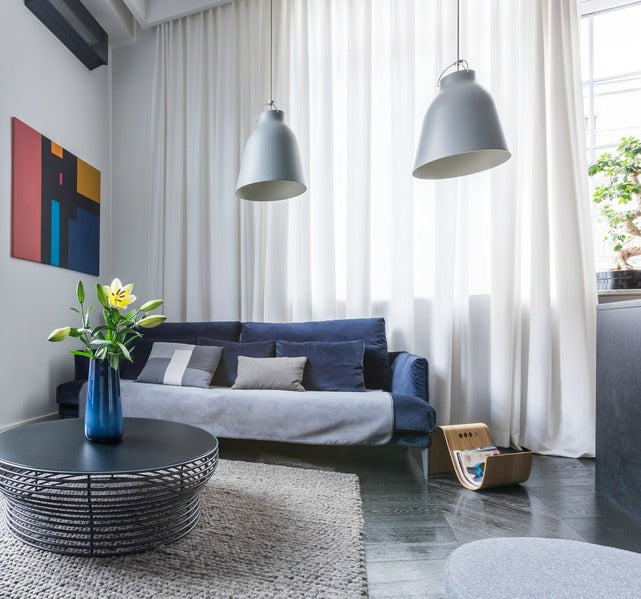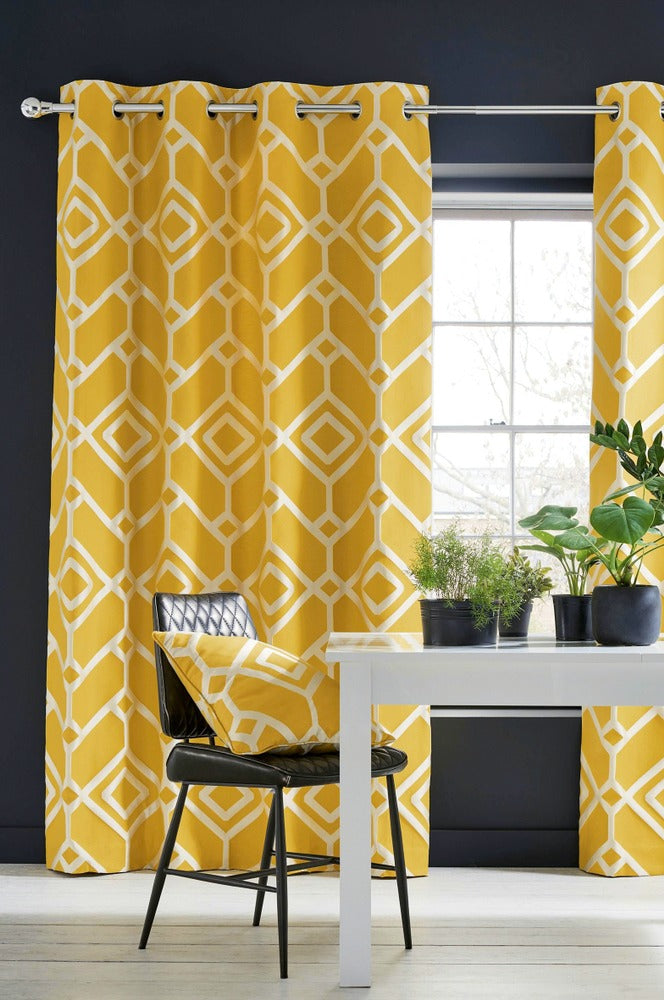How to Measure for Curtains
Window treatments are an important element of the décor of a room and help define the style of a space. The material used for draperies, the style of the curtain, the hardware used and the way they are hung all contribute to the look. If curtains are not hung properly, they can look disproportionate or affect the overall look of the interior. In addition, some curtains can be seen from the exterior and contribute to the street appeal of a home. Here, we provide instructions on how to measure windows for curtains to make sure draperies are displayed to their best advantage.
Define Your Style

You must decide what decorative effect you would like to create before you take measurements. The way to measure depends on how the drapery will be mounted on the window. Formal draperies are usually hung outside the frame and extend beyond the frame several inches on each side. Casual draperies can be hung either inside or outside the frame.
If the window molding is attractive and you would like to highlight it, an inside mount will showcase the frame. For windows that are not so attractive, installing the curtain outside the frame hides flaws. Outside mounts also offer better thermal and light insulation. Installing curtains outside the frame makes windows look larger. In addition, it allows the curtain to be pulled open completely, which gives an unobstructed view of and through the window.
Next, you must decide how many layers of curtains you would like and choose the header style for each layer. The header is the way the curtain is gathered and attaches to the pole. Some curtains rest on the pole, and some attach with rings or hooks. Some styles of curtain headers extend above the pole. Curtains are measured differently depending on the type of header. For example, rod pocket curtains require more panels to get the proper fullness across the width. In contrast, pleated curtains have the fullness built into the pleat. Finally, you will want to determine the length.
Formal draperies are usually fuller and longer than casual or tailored curtains. Formal styles normally either touch the floor or puddle on the floor. Casual styles can be any length: with a drop that lets the curtain rest on the window sill, fall just below the window frame or fall to the floor. The drop is the curtain length measured from the top to the bottom edge.
You must also take into account the scale of the room. If your room has high ceilings, designers recommend hanging draperies close to the ceiling. Otherwise, the curtain divides the wall, which can make a room feel cold. For vaulted rooms or those that span two stories, hang curtains high above the windows to create a focal point and draw attention to the architectural features. If you want to give the illusion of a higher ceiling, install the rods higher above the window and closer to the ceiling. The height will affect the measurement of the length.
How to Measure Windows for Curtains
Precise measurements are a must to get the right fit. Always use a steel tape measure. Cloth tapes can stretch and affect measurements. Measure to the nearest 1/8-inch. Measure each window or doorway individually. Although windows may look as if they are the same size, often they are not.
Make a sketch of each window and note the measurements. These measurements will be used to determine the curtain width and length. Ready-made curtains come in standard widths and lengths. Common lengths are 54, 63, 72, 84, 95, 108 and 120 inches. Café curtains come in two standard lengths of 24 and 36 inches. Although widths of ready-made curtains may vary according to the style, standard widths are approximately 27, 44, 54, 66 and 132 inches. This measurement corresponds to the width of each curtain panel. If you are using ready-made curtains, buy as many panels as needed to get the fullness you want. If you are ordering custom-made curtains, be sure to specify the style of curtain heading and provide accurate window measurements to the company making them.
Calculate the Drop

To determine the length, measure from the rod or window frame to the point where you want your curtain to end. If a curtain pole is already installed, calculate length from the top of the rod. Rods are usually installed a minimum of four inches above the window. However, if you want the pole to be part of the window decoration, measurements should be taken from the eye of the curtain ring that hangs below the pole. To calculate length for an inside mount, take three measurements from the inside of the frame. For an outside mount, take three measurements from the top of the frame. Use the longest length for both inside and outside mounts.
For sill-length curtains, measure to the sill and subtract ½-inch. If you would like the curtain to fall below the sill, the curtain should extend 6 inches below the bottom of the frame. For floor-length curtains, measure to ½-inch above the floor. For a more formal look, add one inch to the drop of the curtain so that the curtain rests on the floor. For puddling, add between two and 10 inches depending on the look you want. More puddling gives a richer, more elegant look. If you plan on opening and closing the curtains often, puddling is not recommended. Puddling is also not recommended for stiff fabrics because they will not fall gracefully.
Determine the Width

To calculate the width for an inside mount, take three measurements across the window inside the frame. Use the narrowest measurement for inside mounts. To calculate the width for an outside mount, take three measurements across the window on the outside of the frame, and use the widest measurement.
There are several ways to determine curtain width. Each corresponds to a particular decorative style. For a tailored look, multiply the width of the window by 1.5. This amount of fullness will cover the window but appear flat when closed. Eyelet curtains and tab-top curtains look good in this style. Standard fullness is calculated by doubling the width of the window. Pencil pleats and French pleats are usually used with this measurement. When the curtains are closed, they will be softly gathered. For a full look with deep folds, triple the width. Rod-pocket curtains and café curtains look good in this style. Adding an extra inch to the width allows the curtains to overlap in the middle when they are closed.
For outside mounts, rods should extend at least four inches beyond the frame on each side. This figure does not include the finials, or decorative endcaps. Add at least eight inches to the total width of the curtain to account for the extension to the sides. Extending the curtain several inches beyond the frame provides better light control and helps prevent drafts.
Choose the Fabric

Each curtain style achieves its look and elegance by the fullness of the fabric and the gracefulness of the cascade of the cloth from the rod. Silks, cottons, linens and some polyesters work well with almost all styles. Formal draperies are often made of heavier fabrics, such as heavy silks, jacquards, velvets and brocades. Sheers are just that—panels made of light, translucent fabrics. Fuller draperies require more cloth but give an opulent, rich look. Tailored curtains such as eyelets work well with stiff fabrics that keep the shape of the pleat or gather. However, stiff fabrics do not puddle well. Satins and lightweight silks create a dramatic cascade. If you are ordering custom-made curtains, be sure to speak with the manufacturer about the look you want and choose fabrics accordingly.
Double-check the window measurements, calculate the desired width and decide what length looks best. Select curtain fabrics that will give the cascade and fullness that you prefer. With a bit of planning and attention to detail, you can design a window treatment that makes a strong decorative statement and complements your interior décor.
Feel free to join in our Affiliate Programs
Recommended For You
5.0 / 5.0
17 reviews- Zuri/Natural-White
- Zuri/Gray-Blue
- Zuri/Light Green
- Zuri/Light Pink
- Zuri/Yellow
- Zuri/Sand
4.98 / 5.0
47 reviews- Solene/Purple
- Solene/Dark Gray
- Solene/Light Beige
- Solene/Dark Beige
- Solene/Sand
- Solene/Light Gray
- Solene/Sky Blue
- Solene/Baby Blue
4.91 / 5.0
11 reviews- Olivia/White
- Olivia/Khaki
- Olivia/Light Gray
- Olivia/Brownish
- Olivia/Dark Gray
- Olivia/Mint Green
- Olivia/Navy Blue
- Olivia/Blue
- Olivia/Cream
- Olivia/Dark Brown
- Olivia/Gray
- Olivia/Pink
- Olivia/Grass Green
- Olivia/Dark Green
- Olivia/Black
5.0 / 5.0
26 reviews- Sienna/Black
- Sienna/Light Gray
- Sienna/White
- Sienna/Beige Yellow
4.95 / 5.0
22 reviews- Isabel/Bluish Gray
- Isabel/Cream White
- Isabel/Grayish White
- Isabel/Dark Gray
- Isabel/Sky Blue
- Isabel/Coffee
5.0 / 5.0
4 reviews- Charlotte/Olive Green
- Charlotte/Beige
- Charlotte/Dark Khaki
- Charlotte/Brown
- Charlotte/Lime Green
- Charlotte/Blue Gray
- Charlotte/Peach Pink
- Charlotte/Brownish
- Charlotte/Light Gray
- Charlotte/Steel Gray
- Charlotte/Smokey Purple
- Charlotte/White
- Charlotte/Green
- Charlotte/Orange
- Charlotte/Dark blue
4.33 / 5.0
3 reviews- Emma/Natural
- Emma/Chocolate Natural
- Emma/Pine Natural
- Emma/Gray
- Emma/Ochre Natural
5.0 / 5.0
5 reviews- Celeste/Grayish White
- Celeste/Dark Beige
- Celeste/Dark Gray
- Celeste/Light Gray
- Celeste/Light Beige
- Celeste/Dark Brown
- Celeste/Sky Blue
- Celeste/Blue
- Celeste/Navy Blue
- Celeste/Gray
- Sophia/White
- Sophia/Light Beige
- Sophia/Wheat
- Sophia/Pink
- Sophia/Lake Blue
- Sophia/Navy blue
- Sophia/Light Gray
- Sophia/Dark Gray
- Sophia/Coffee
- Sophia/Brown
- Sophia/Grass Green
- Sophia/Orange
- Sophia/Black
- Sophia/Aquamarine
4.96 / 5.0
25 reviews- Clara/Natural
- Clara/Light Gray
4.92 / 5.0
13 reviews- Heloise/Navy Blue
- Heloise/Grayish White
- Heloise/Light Brown
- Heloise/Sand
- Heloise/Light Gray
- Heloise/Gray
- Heloise/Rose
- Heloise/Dark Blue
- Heloise/Light Blue
- Heloise/Baby Blue
- Heloise/Light Green
- Heloise/Grass Green
- Heloise/Dark Green
- Heloise/Coffee
- Elodie/Dark Gray
- Elodie/Black
- Elodie/Light Gray
- Elodie/Pink
- Elodie/Green
- Elodie/Beige
- Elodie/Gray
- Elodie/Light Coffee
- Elodie/Brown
- Elodie/Blue
4.8 / 5.0
5 reviews- Luna/Dark Gray
- Luna/Light Gray
- Luna/Black
- Luna/Natural
- Nicolette/Light Beige
- Nicolette/Light Gray
- Nicolette/Grayish White
- Nicolette/Brown
- Nicolette/Cinnamon
- Nicolette/Coffee
- Nicolette/Pinkish Purple
- Nicolette/Light Blue
- Nicolette/Lake Blue
- Nicolette/Blue
- Nicolette/Dark Blue
- Nicolette/Dark Brown
- Nicolette/Dark Gray
- Aspasia/Cream White
- Aspasia/Gray
- Aspasia/Light Gray
- Aspasia/Blue Gray
- Aspasia/Taupe
- Aspasia/Khaki
- Aspasia/Rose
- Aspasia/Matche Green
- Aspasia/Dark Blue
- Cecilia/Grass Green
- Cecilia/Cream White
- Cecilia/Tea Milk
- Cecilia/Light Gray
- Cecilia/Gray
- Cecilia/Dark Gray
- Cecilia/Haze Blue
- Cecilia/Kahki
- Cecilia/Dark Brown
- Yvonne/Creamy Cloud
- Yvonne/Warm Beige
- Yvonne/Latte Brown
- Yvonne/Peach Pink
- Yvonne/Silver Grey
- Yvonne/Slate Grey
- Yvonne/Walden Blue
- Yvonne/Royal Blue
- Yvonne/Olive Green
- Yvonne/Avocado Green
- Yvonne/Alice Blue
- Ash1
- Ash2
- Salome/Green
- Salome/White
- Salome/Beige
- Salome/Light Gray
- Salome/Dark Gray





























